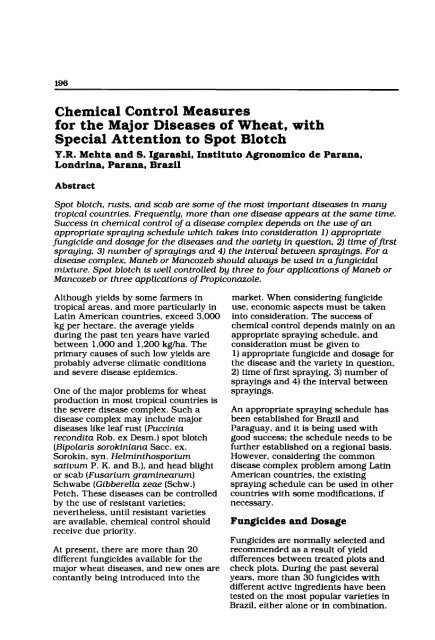the Symposium on Wheats for More Tropical Environments - cimmyt
the Symposium on Wheats for More Tropical Environments - cimmyt
the Symposium on Wheats for More Tropical Environments - cimmyt
- No tags were found...
You also want an ePaper? Increase the reach of your titles
YUMPU automatically turns print PDFs into web optimized ePapers that Google loves.
196Chemical C<strong>on</strong>trol Measures<strong>for</strong> <str<strong>on</strong>g>the</str<strong>on</strong>g> Major Diseases of Wheat, withSpecial Attenti<strong>on</strong> to Spot BlotchY.R. Mehta and S. Igarashi, Instituto Agr<strong>on</strong>omico de Parana,L<strong>on</strong>drina, Parana, BrazilAbstractSpot blotch. rusts, and scab are some of <str<strong>on</strong>g>the</str<strong>on</strong>g> most important diseases in manytropical countries. Frequently, more than <strong>on</strong>e disease appears at <str<strong>on</strong>g>the</str<strong>on</strong>g> same time.Success in chemical c<strong>on</strong>trol of a disease complex depends <strong>on</strong> <str<strong>on</strong>g>the</str<strong>on</strong>g> use ofanappropriate spraying schedule which takes into c<strong>on</strong>siderati<strong>on</strong> 1) appropriatefungicide and dosage<strong>for</strong> <str<strong>on</strong>g>the</str<strong>on</strong>g> diseases and <str<strong>on</strong>g>the</str<strong>on</strong>g> variety in questi<strong>on</strong>. 2) time offirstspraying. 3) number ofsprayings and 4) <str<strong>on</strong>g>the</str<strong>on</strong>g> interval between sprayings. For adisease complex. Maneb or Mancozeb should always be used in afungicidalmixture. Spot blotch is well c<strong>on</strong>trolled by three tofour applicati<strong>on</strong>s ofManeb orMancozeb or three applicati<strong>on</strong>s ofPropic<strong>on</strong>azole.Although yields by some farmers intropical areas, and more particularly inLatin American countries, exceed 3,000kg per hectare, <str<strong>on</strong>g>the</str<strong>on</strong>g> average yieldsduring <str<strong>on</strong>g>the</str<strong>on</strong>g> past ten years have variedbetween 1,000 and 1.200 kg/ha. Theprimary causes of such low yields areprobably adverse climatic c<strong>on</strong>diti<strong>on</strong>sand severe disease epidemics.One of <str<strong>on</strong>g>the</str<strong>on</strong>g> major problems <strong>for</strong> wheatproducti<strong>on</strong> in most tropical countries is<str<strong>on</strong>g>the</str<strong>on</strong>g> severe disease complex. Such adisease complex may include majordiseases like leaf rust (Pucciniarec<strong>on</strong>dita Rob. ex Desm.) spot blotch(Bipolaris sorokiniana Sacco ex.Sorokin, syn. Helminthosporiumsativum P. K. and 8.). and head blightor scab (Fusarium graminearum)Schwabe (Gibberella zeae (Schw.)Petch. These diseases can be c<strong>on</strong>trolledby <str<strong>on</strong>g>the</str<strong>on</strong>g> use of resistant varieties;never<str<strong>on</strong>g>the</str<strong>on</strong>g>less. until resistant varietiesare available. chemical c<strong>on</strong>trol shouldreceive due priority.At present, <str<strong>on</strong>g>the</str<strong>on</strong>g>re are more than 20different fungicides available <strong>for</strong> <str<strong>on</strong>g>the</str<strong>on</strong>g>major wheat diseases. and new <strong>on</strong>es arec<strong>on</strong>tantly being introduced into <str<strong>on</strong>g>the</str<strong>on</strong>g>market. When c<strong>on</strong>sidering fungicideuse. ec<strong>on</strong>omic aspects must be takeninto c<strong>on</strong>siderati<strong>on</strong>. The success ofchemical c<strong>on</strong>trol depends mainly <strong>on</strong> anappropriate spraying schedule. andc<strong>on</strong>siderati<strong>on</strong> must be given to1) appropriate fungicide and dosage <strong>for</strong><str<strong>on</strong>g>the</str<strong>on</strong>g> disease ana <str<strong>on</strong>g>the</str<strong>on</strong>g> variety in questi<strong>on</strong>.2) time of first spraying. 3) number ofsprayings and 4) <str<strong>on</strong>g>the</str<strong>on</strong>g> interval betweensprayings.An appropriate spraying schedule hasbeen established <strong>for</strong> Brazil andParaguay. and it is being used withgood success; <str<strong>on</strong>g>the</str<strong>on</strong>g> schedule needs to befur<str<strong>on</strong>g>the</str<strong>on</strong>g>r established <strong>on</strong> a regi<strong>on</strong>al basis.However. c<strong>on</strong>sidering <str<strong>on</strong>g>the</str<strong>on</strong>g> comm<strong>on</strong>disease complex problem am<strong>on</strong>g LatinAmerican countries, <str<strong>on</strong>g>the</str<strong>on</strong>g> existingspraying schedule can be used in o<str<strong>on</strong>g>the</str<strong>on</strong>g>rcountries with some modificati<strong>on</strong>s, ifnecessary.Fungicides and DosageFungicides are normally selected andrecommendf'd as a result of yielddifferences between treated plots andcheck plots. During <str<strong>on</strong>g>the</str<strong>on</strong>g> past severalyears. more than 30 fungicides withdifferent active ingredients have beentested <strong>on</strong> <str<strong>on</strong>g>the</str<strong>on</strong>g> most popular varieties inBrazil. ei<str<strong>on</strong>g>the</str<strong>on</strong>g>r al<strong>on</strong>e or in combinati<strong>on</strong>.

















